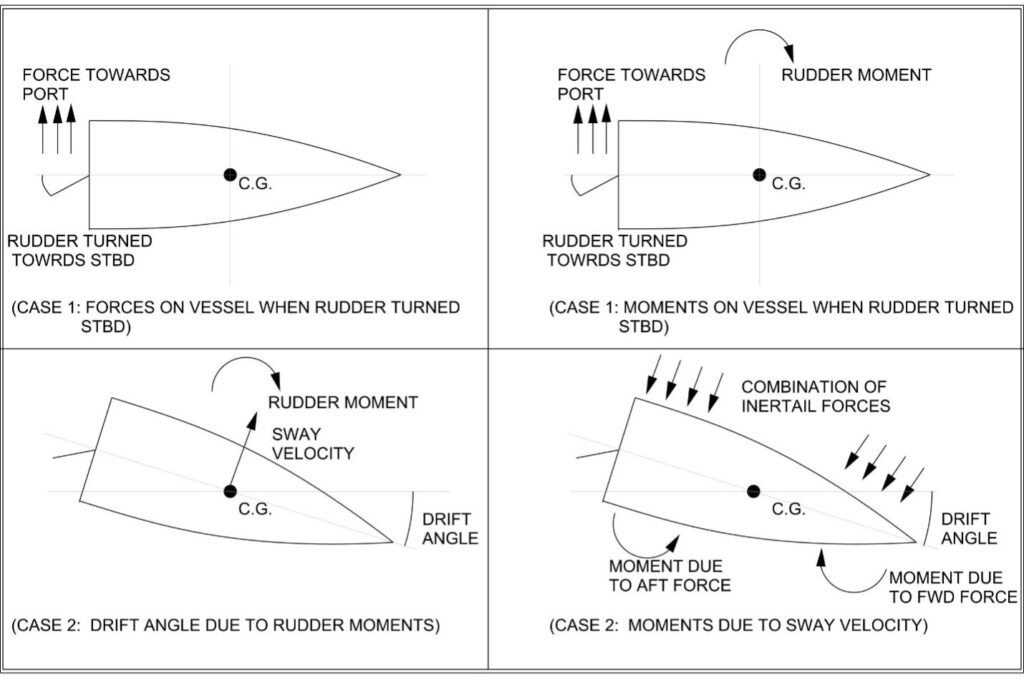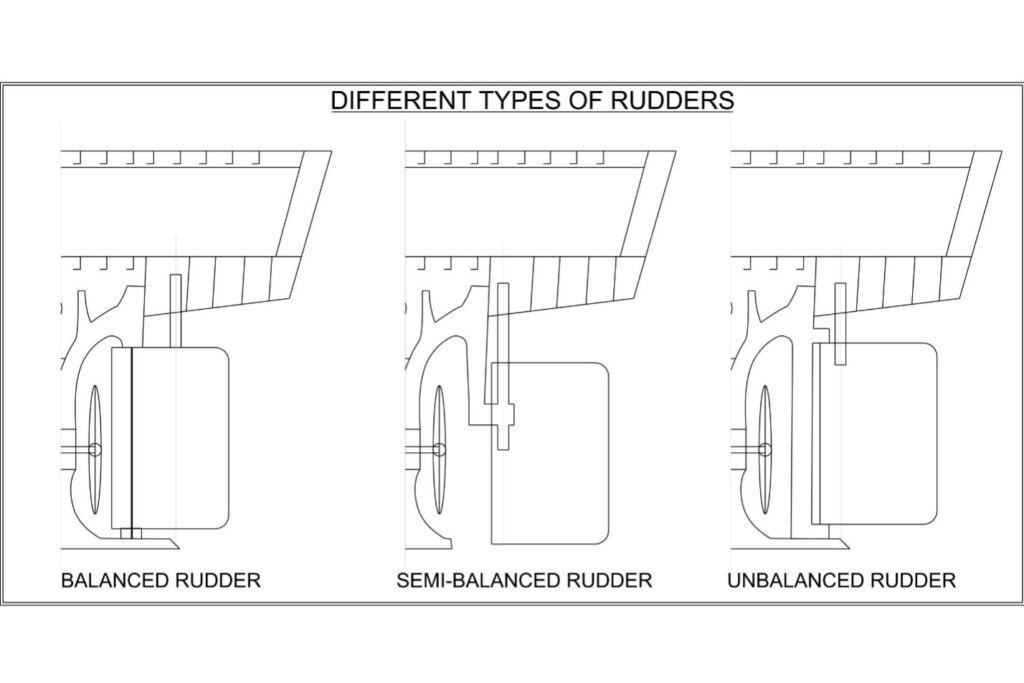Have you ever wondered why every ship has rudders? Why isn’t the ship’s bow (the forward part) equipped with a rudder? Or why is it usually positioned behind the propeller, for that matter?
A ship’s rudder is a tool that gives the ship directional control and a way to steer so that it can navigate. This is accomplished by directing water flow as effectively and with as little resistance as possible to not compromise the vessel’s efficiency.
In this article, we shall learn more about the functioning of the propeller, the different types, and so on.
The Principle Behind The Operation Of The Rudder
When a vessel turns the dynamics of the vessel change about the rudder which induces a change in the path of the vessel, let us consider the following situation and subdivide in terms of different aspects, assuming a starboard turn.

- Forces and Moments
when the rudder changes its angle from its neutral position, due to the change in the flow of the water around the rudder a lift force is generated. This lift force is directed in the direction opposite to which the rudder is turned.
As you can see, this rudder force is applied to the ship in a transverse direction. In other words, the rudder force is nothing more than a sway force towards the port side, this force will cause the ship to achieve a sway velocity towards the port side.
Because of this, when the rudder is turned over to hard starboard, a ship will swing slightly to the port. However, this wobble is so slight about the starboard that it hardly registers. But the sway does happen.
The ship is also affected by another aspect of the rudder force. It generates a moment around the ship’s center of gravity in the direction in the below figure. The center of gravity of the ship is forward of the rudder, so given the direction of the rudder force, a moment will be created as shown below
Consider the ship’s size concerning the size of a rudder. Do you think solely the rudder can help the vessel turn? So how does the ship’s rudder turn? A ship cannot be turned by its rudder alone. In reality, the amount of rudder moment needed to turn the ship by the desired heading angle is minuscule. If that’s the case, what causes the ship to turn?
- Drift Angle
The ship’s orientation is somewhat altered by a drift angle when the rudder moment acts about its center of gravity. The only thing a designer needs to do is ensure that the rudder moment is sufficient to introduce a little drift angle into the ship’s movement. This moment is not large enough to turn the ship to the desired heading angle.
With that drift angle, the ship is currently sailing in the original direction. However, this is no longer a pure surge. If you follow, you’ll find that you may calculate the ship’s velocity in both the longitudinal (surge) and transverse (sway) directions.
The rudder has given the ship a slight surge velocity by establishing a drift angle. Doesn’t this serve to emphasize the cause of the slight port-side sway that occurs during a starboard turn?
The subsequent events are what cause the ship to turn. Let’s not concentrate on the surge velocity here to unravel the riddle of the turning of a ship. The sway element should receive the majority of attention. Because of the sway velocity component, the ship turns by altering the hydrodynamics around its hull.
The Impact Of The Sway Velocity And How It Affects The Ship
The hull sways with a sway velocity towards the side opposite to which the rudder is changed. When it accomplishes this, it applies pressure to the water particles on the opposite side.
Due to their inherent inertia, the water particles in turn exert an opposing force on the ship’s hull. Since inertia forces always oppose the motion, their direction is always the opposite of the sway velocity. As a result, there is an inertia force acting in the opposite direction on the ship’s hull.
What’s crucial to understand in this case is that when the ship’s hull exerts a force on the water around it during its sway velocity to the port, the inertia force that the water is exerting on the hull tries to achieve equilibrium, meaning that its magnitude is on the order of the displacement of the ship.
Therefore, the magnitude of the resulting hydrodynamic moment when it acts on the ship is in the order of the displacement of the ship. This moment can turn the ship, unlike the moment caused by the rudder force alone.
As you can see, however, this hydrodynamic moment would not have been present if the ship had not developed a drift angle or a sway velocity component, which was primarily caused by the rudder’s action.
The inertial force mentioned above can now be divided into two categories. One is the portion that affects the ship’s stern (inertia force at the stern), and the other portion affects the bow (inertia force at the bow).
Inertia forces in the stern will produce an anticlockwise (towards port) moment about the center of gravity, whereas inertia forces at the bow will produce a clockwise (towards starboard) moment about the center of gravity.
The hull is constructed so that the sway inertia forces at the bow are greater than those at the stern. As a result, the moment is generated toward the starboard.
How The Positioning Of The Rudder Is Crucial For The Maneuvering Characteristics Of A Vessel
Let us consider the following condition, When the rudder is turned to starboard, a force is created toward the port let’s call it the rudder force. Take note of the direction of the rudder moment that the rudder force produced about the center of gravity. The rudder moment was in the starboard direction (to create a drift angle towards the starboard).
Imagine putting the rudder in forward of the vessel rather than aft at this point. The rudder force would still be in the port direction even at a starboard angle.
What about the CG-related incident, though? Imagine the rudder moment being toward the port, causing a drift angle toward the port, and the ship turning to the port due to the net hydrodynamic moment. In contrast, you made a starboard turn by turning the rudder. See the issue?
Let us also look into the location of the rudder concerning the propeller. The propeller accomplishes nothing more than accelerating the speed at which water exits its slipstream from the hull. Additionally, the rudder force (lift) produced is inversely related to the speed of the water falling on it.
Therefore, in terms of location, if a rudder is attached to the propeller after it, the increased propeller outflow velocity produces a bigger lift force.
The magnitude of the turning effect, however, won’t be the same if a rudder is positioned just ahead of the propeller because the flow on the rudder isn’t as strong as it would be if it were positioned behind the propeller slipstream.
What Are The Different Types Of Rudders?
Different ships utilize a variety of rudder types. The size of the rudder has a significant impact on how the ship turns. Different ship types require different amounts of rudder area. The area, shape, ship speed, and helm angle all affect how much force is applied to the rudder. Professionals determine the rudder’s required size approximation.

Rudders are classified as the following,
- Balanced Rudder
A spade rudder is essentially a rudder plate that is only attached to the rudder stock at the rudder’s top. In other words, the rudder stock, also known as the rudder axis, does not follow the length of the rudder.
In reality, whether a rudder is balanced or semi-balanced depends on where the rudder stock is located along the chord of the rudder (width meaning, from the forward to aft end of the rudder).
The rudder stock is positioned so that 40% of the rudder area is forward of the stock and the remaining is aft of it in balanced rudders, as spade rudders often are.
The rudder’s center of gravity will be around 40% of its chord length from its forward end. The torque needed to rotate the rudder will be substantially lower if the rudder’s axis is located close to this point than it would be if it were placed at the forward end of the rudder
- Un Balanced rudder
The stocks on these rudders are fastened at the frontmost part of their span. The rudder stock runs parallel to the length of the rudder’s chord. In this situation, much more torque is needed to turn the rudder than would be needed for a comparable balanced rudder.
To prevent the rudder from shifting vertically from its original position, the topmost portion of the rudder must be fixed to the spindle. Unbalanced rudders are not commonly used today, though.
- Semi-balanced rudder
As suggested by the name, the rudder is partially balanced and partially unbalanced. The upper portion’s imbalance will assist protect the rudder from vertical movement by serving as structural support.
Furthermore, the balanced component will produce less torque when the rudder is swung. As a result, if the steering gear equipment malfunctions during a turn, a semi-balanced rudder automatically returns to the centerline orientation.
Again, there are two sorts of semi-balanced rudders depending on the depth of the horn (which affects the response and torque characteristics of the rudder).
A shallow horn rudder has a horn that projects from the top barely half the length of the rudder’s chord. A deep horn rudder, on the other hand, has a horn that protrudes from the top of the rudder up to more than 50% of its chord length.
Summary
The rudder is an important component that helps in turning the vessel. The proper design and placement of the rudder make sure that the vessel is well-maneuverable.
- Sustainable and Luxurious: Discovering Split’s Yachting Paradise – April 26, 2024
- MarineTraffic vs VesselFinder: Which Is Better Vessel Tracking Service? – February 14, 2024
- Port Costs: A Comprehensive Guide to Port Dues and Fees for Cargo Ships – February 12, 2024





Leave a Reply